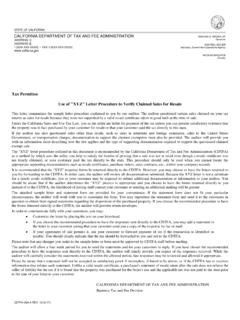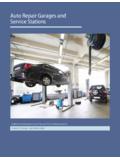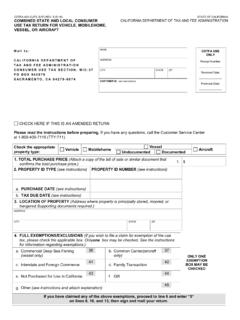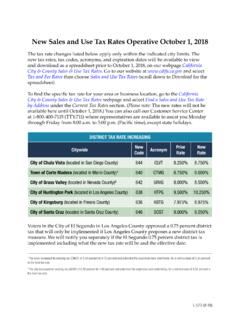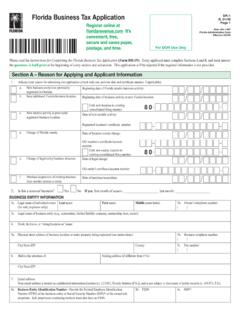Transcription of Sales and Use Taxes: Exemptions and Exclusions
1 Sales and Use Taxes: Exemptions and ExclusionsCalifornia Revenue and Taxation Code Part 1, Division 2 FOREWORDSALES AND USE TAXESEXEMPTIONS AND EXCLUSIONSThis publication summarizes the Exemptions and Exclusions from Sales and use tax in effect when the publication was printed (as noted on the front cover). However, statutory or regulatory changes may have occurred since that time. If there is a conflict between the text in this publication and the law, the decision will be based on the law and not this general, California Sales and use taxes are imposed on the retail sale or the use of tangible personal property in this state.
2 Since the enactment of the Sales and Use Tax Law in 1933, many Exemptions have been granted that remove the liability for tax for various types of property and certain individuals or organizations. In addition to complete Exemptions , provisions have been enacted that reduce the tax base by defining certain persons to be consumers of property sold, or provide a partial exemption or credit. Other transactions are excluded from the imposition of Sales and use taxes because of basic definitions contained in the law or because they do not involve the transfer of following two comprehensive listings are intended to identify and provide a brief general description of Exemptions and Exclusions from the imposition of California Sales and use taxes, first by category and second by alphabetical reference.
3 The explanations are not meant to provide detailed information as to the requirements or conditions of qualifying for exemption, and should not be used as a legal reference. For example, not all nonprofit organizations qualify for the Exemptions and special rules summarized in this publication. The California Sales and Use Tax Law, as implemented by duly adopted regulations of the California Department of Tax and Fee Administration (CDTFA), should be consulted to determine the requirements and complete description of the Exemptions and Exclusions identified by the listing by category places the Exemptions and Exclusions into the following categories: I.
4 Necessities of Life; II. General Public Benefit; III. Industry Benefit; IV. Exclusions by Definition; and V. Other Exemptions , Exclusions , or Credits. In addition to identifying the Exemptions and Exclusions , this listing provides the section(s) of the Sales and Use Tax Law that provides the exemption or exclusion along with an estimate of annual revenue lost, if available. Revenue lost refers to revenue which is not realized due to the exemption or exclusion and includes both state and local revenue. The estimates of revenue lost are based on the most recent data available and are provided to give an order of magnitude of the revenue lost attributable to the exemption or exclusion.
5 It should be noted that the amount of revenue lost is not extracted from the Sales and Use Tax returns filed with the CDTFA by taxpayers, since taxpayers are not required to report Sales by commodity. In order to estimate the revenue lost attributable to the various Exemptions and Exclusions , the CDTFA relies on data from outside sources. However, for many of the Exemptions and Exclusions contained in this publication, reliable data is not available. Where the revenue lost is not known because the information is not available, N/A is some cases, the publication identifies certain sellers and lessors as consumers of the tangible personal property they sell or lease.
6 These persons do not owe Sales tax on their transfers of the property. Instead, the sale to them or their use is subject to Sales or use tax. The Sales to them are not nontaxable Sales for placing of Exemptions and Exclusions into categories is in many instances subjective. Many provisions of the law impact numerous types of individuals or businesses. However, an attempt was made to place the Exemptions or Exclusions within the category that is perceived to be the main beneficiary of the granting of relief from tax, or that was intended to benefit from the enactment of specific A: Categorized Listing Sales and Use Tax Exemptions and Exclusions (By category).
7 1 Index ..22 SECTION B: Alphabetical Listing Sales and Use Tax Exemptions and Exclusions (Alphabetical) ..27 Index of Sales and Use Tax Regulations ..44 FOR MORE INFORMATION ..46- 1 -SECTION ASALES AND USE TAXEXEMPTIONS AND Exclusions (BY CATEGORY)I. NECESSITIES OF LIFE Provisions that exempt property necessary to the sustenance of life. A. Food FOOD PRODUCTS Sales of food for human consumption are generally exempt from tax unless sold in a heated condition (except hot bakery items or hot beverages, such as coffee, sold for a separate price), served as meals, consumed at or on the seller s facilities, ordinarily sold for consumption on or near the seller s parking facility, or sold for consumption where there is an admission charge.
8 REVENUE: $ billion SECTION: 6359 CANDY, CONFECTIONERY, SNACK FOODS, AND BOTTLED WATER The exemption for Sales of food products includes candy and confectionery, snack foods and bottled water. REVENUE: $963 million SECTION: 6359 FOOD PRODUCTS SOLD THROUGH vending MACHINES The vending machine operator is the consumer of (1) food products which sell at retail for fifteen cents or less and (2) food products which are sold through a bulk vending machine for twenty-five cents or less. For Sales of cold food products, hot coffee, hot tea and hot chocolate through other vending machines at a price greater than fifteen cents, 67% of the receipts from such Sales are also exempt from tax.
9 REVENUE: $25 million SECTIONS: and ANIMAL LIFE, FEED, SEEDS, PLANTS AND FERTILIZER, DRUGS AND MEDICINES The sale and use of animal life or feed for animal life, seeds, and plants the products of which normally constitute food for human consumption are exempt from tax. The sale and use of fertilizer to be applied to land the products of which are to be used for human consumption are also exempt. In addition, the sale and use of drugs and medicines including oxygen that are administered to food animals, the primary purpose of which is the prevention or control of disease, are exempt from tax. This is an expansion of the general food exemption.
10 REVENUE: $ billion SECTION: 6358 MEDICATED FEED AND DRINKING WATER The sale and use of drugs or medicines administered to animal life as an additive to feed or drinking water, the primary purpose of which is the prevention and control of disease of food animals, or of nonfood animals which are to be sold in the regular course of business, are exempt from tax. REVENUE: $500,000 SECTION: PURCHASES MADE WITH CALFRESH BENEFITS When otherwise taxable purchases are made with CalFresh benefits, only the amounts paid with CalFresh benefits are exempt from tax. Amounts paid with forms of consideration other than CalFresh benefits, such as cash or manufacturer s coupons, remain taxable.



